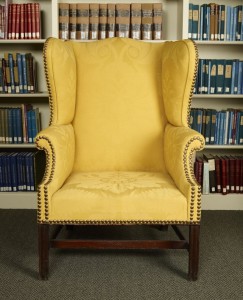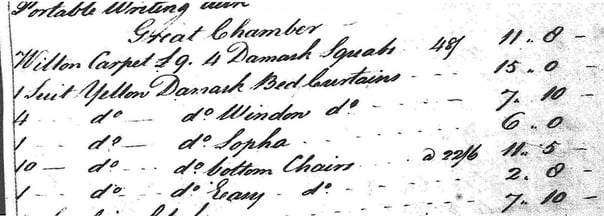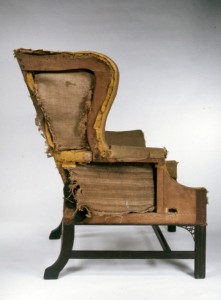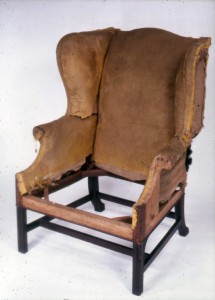 Figure 1. The Hancock easy chair with its replaced yellow worsted damask upholstery. The chair is currently on display at the NEHGS Library. Photo by Greg Anthony
Figure 1. The Hancock easy chair with its replaced yellow worsted damask upholstery. The chair is currently on display at the NEHGS Library. Photo by Greg Anthony
In addition to its vast collection of genealogical materials, the New England Historic Genealogical Society houses a fine collection of early American furniture and decorative arts. Scattered throughout the Society’s Newbury Street headquarters are superb examples of eighteenth-century tall case clocks, high chests, and desks. Some of these pieces possess quite interesting provenances, including an easy chair believed to have been owned by eighteenth-century Boston merchant and Massachusetts governor John Hancock (Fig. 1).
According to NEHGS records, the Hancock easy chair originally stood in Hancock’s Beacon Hill home, which he had inherited from his uncle Thomas’ wife, Lydia Henchman, sometime after Thomas’ death in 1764.[i] It is believed that the chair is the “Yellow Damask Easy Chair” listed in John Hancock’s 1793 estate inventory (Fig. 2).[ii]
 Figure 2. An excerpt from John Hancock’s 1793 estate inventory. The entry for the yellow damask easy chair appears at the bottom of the image, and was part of the contents of the “Great Chamber.”
Figure 2. An excerpt from John Hancock’s 1793 estate inventory. The entry for the yellow damask easy chair appears at the bottom of the image, and was part of the contents of the “Great Chamber.”
According to Rebecca J. Bertrand, the Hancock chair may have been acquired shortly after Hancock’s death by a member of Mary Davis’ family at an auction held in Boston on 23 October 1793.[iii] NEHGS obtained the chair in 1882 as a gift from the Rev. Edmund F. Slafter,[iv] a former Secretary of the New England Historic Genealogical Society. The chair was originally part of the Society’s “Governors’ Chairs” collection, which was housed at the its Somerset Street address. The provenance of each of the six chairs in the collection was associated with a particular governor of a New England state. Unfortunately, the original collection of six chairs no longer exists.[v]
Brock Jobe, furniture historian and professor emeritus of American Decorative Arts at the Winterthur Museum in Delaware, posits that the Hancock chair dates to the late 1760s and is not American made, but likely of English manufacture.[vi] According to Jobe, two characteristics help to date the piece.
The straight, square front legs of the chair were a typical design feature of the 1760s, as were the pierced decorative brackets located at the sides of the front corners of the chair (where the front legs meet the seat). Jobe explains that the chair would have originally had these brackets not only at the sides of the chair, but at the front as well. At present, the Hancock chair is missing these front brackets.[vii] Given the approximate age of the chair, Rebecca Bertrand postulates that the easy chair would have likely been purchased by John Hancock himself, and not earlier by his uncle Thomas.[viii]
Jobe also cites several features that point to the chair’s English origins. First off is the material. The primary wood of the Hancock chair (the finished wood visible to the observer) is made of mahogany, which was used frequently in both American and English furniture of the time.[ix] However, the secondary wood (the wood that comprises the interior frame of the chair) is made of spruce and beech—woods typically used in English furniture. If the chair was made in Boston, one would expect the secondary wood to be maple, birch, or white pine, not spruce and beech.
The overall dimension of the chair is another clue. Like other examples of English easy chairs, the Hancock chair is quite wide and sits low to the ground. In comparison, American examples are generally narrower and more vertical in orientation.
 Figure 3. This profile shot of the Hancock chair provides views of the chair’s curved back legs and pierced decorative brackets, located at the front of the chair. Photo by Richard Cheek
Figure 3. This profile shot of the Hancock chair provides views of the chair’s curved back legs and pierced decorative brackets, located at the front of the chair. Photo by Richard Cheek
Lastly, a particular design characteristic: the back legs of the Hancock easy chair are raked backward and terminate in block-shaped feet (Fig. 3). These features are common in English furniture, but quite rare in American examples.[x]
Construction of the chair would have required the talents of two separate groups of craftsmen: cabinetmakers and upholsterers. “Cabinetmaker” or “shop joiner” were common terms used for furniture makers in the eighteenth century.[xi] The cabinetmaker(s) would have cut and shaped the wood necessary to build the frame of the chair and then secured these pieces together. Cabinetmakers were also responsible for decorative elements found on the surface of the wood, including any carving, molding, or veneering.
The cabinetmaker who constructed the Hancock chair relied primarily upon mortise and tenon joinery to assemble the chair—a common woodworking technique where a tenon fits into a corresponding mortise or hole.[xii] The cabinetmaker also employed subtle decorative techniques in the carving of the pierced brackets at the sides of the chair and the fluting on the front legs.
 Figure 4. The Hancock easy chair with its original yellow worsted damask upholstery. Photo by Richard Cheek
Figure 4. The Hancock easy chair with its original yellow worsted damask upholstery. Photo by Richard Cheek
The upholsterer would have provided the necessary padding, and covered the chair in its finished layer of upholstery. Jobe explains that the original upholsterer of the Hancock chair stuffed it with “curled hair”—a combination of horse and pig hair. This form of stuffing is common in English furniture, and provides additional evidence for the chair’s English origins.[xiii] The replaced yellow upholstery covering the chair is worsted damask and is true to the original fabric of the chair. The Hancock chair was originally upholstered in yellow worsted damask (Fig. 4), covered in claret leather in the early 1900s, and then reupholstered using new worsted damask in the late 1970s.[xiv] Worsted damask is composed of high quality wool threads, and would have been an expensive fabric in the eighteenth century.[xv] Given the high cost of the fabric, easy chairs would have been more common in the homes of the wealthy.
Although looked upon as a common (or perhaps antiquated) piece of furniture today, the easy chair was somewhat of a novel invention in the eighteenth century. According to furniture historians Jonathan L. Fairbanks and Elizabeth Bidwell Bates, the easy chair was an “important innovation” in furniture design: “The comfortable easy chair as we now know it was an important innovation from abroad that arrived in this country late in the seventeenth and became popular in the early eighteenth century. Before that time comfort in seating was largely achieved through the use of fully stuffed down pillows.”[xvi]
The design of the easy chair, however, was also utilitarian. Edgar G. Miller, Jr., writes that “The wings [protruding from the sides of the chair back] were meant not only to make the chair comfortable, but also to protect the occupant from the strong drafts which must have resulted from the open fires in the homes of our ancestors.”[xvii] Fairbanks and Bates also note how “Easy chairs were frequently made for the comfort of the aged, ill or infirm,” and were rarely found in “public areas of the house.”[xviii] In fact, the Hancock easy chair was included in the list of furniture found in the “Great Chamber” or bedroom of Hancock’s house.[xix]
The Hancock chair is only one of many examples of easy chairs and seating furniture that appeared in American estate inventories of the eighteenth century. Although usually overlooked in genealogical research, domestic items appearing in probate inventories can provide unique insight into the historical environment in which an ancestor lived. For example, an examination of the Hancock chair not only sheds light upon the artisanal trades and popular styles of the eighteenth century, but also Hancock’s social status as a man of wealth. Be on the look-out the next time you’re researching and consult early estate inventories for pieces of furniture and other household goods. As you research, ask yourself, what do these objects reveal about how an ancestor lived.
Stay tuned for future blog posts that will explore additional examples of early American furniture housed in the collections of NEHGS!
Special thanks to Brock Jobe, professor emeritus of American Decorative Arts at the Winterthur Museum, for his generous help and assistance.
Notes
[i] See the label associated with the chair located at the New England Historic Genealogical Society’s headquarters on Newbury Street in Boston, Massachusetts.
[ii] Suffolk County, Mass., Probate Records, 93: 13; Brock Jobe, e-mail message to author, 18 November 2015.
[iii] Rebecca J. Bertrand, “Myth and Memory: The Legacy of the John Hancock House” (master’s thesis, University of Delaware, 2010), 65-67. Bertrand’s thesis provides a fascinating study of the Hancock house and its contents.
[iv] Hancock chair label at NEHGS [see Note i].
[v] Ibid.
[vi] Jobe, e-mail message to author, 18 November 2015.
[vii] Jobe, telephone interview with author, 30 November 2015.
[viii] Bertrand, “Myth and Memory: The Legacy of the John Hancock House,” 51-52.
[ix] Edgar G. Miller, Jr., American Antique Furniture: A Book for Amateurs (Baltimore: The Lord Baltimore Press, 1937), 1: 80-81.
[x] Jobe, telephone interview with author, 30 November 2015.
[xi] Brock Jobe, “Urban Craftsmen and Design,” in Brock Jobe and Myrna Kaye, New England Furniture: The Colonial Era: Selections from the Society for the Preservation of New England Antiquities (Boston: Houghton Mifflin Company, 1984), 12.
[xii] Jobe, telephone interview with author, 30 November 2015.
[xiii] Ibid.
[xiv] Ibid. See also Hancock chair label at NEHGS [Note i].
[xv] Jobe, telephone interview with author, 30 November 2015. Florence M. Montgomery defines worsted as “Lightweight cloth made of long-staple combed wool yarn.” (Florence M. Montgomery, Textiles in America, 1650-1870 [New York: W. W. Norton & Company, 1984], p. 375).
[xvi] Jonathan L. Fairbanks and Elizabeth Bidwell Bates, American Furniture, 1620 to the Present (New York: Richard Marek Publishers, 1981), 78.
[xvii] Miller, American Antique Furniture: A Book for Amateurs, 1: 238.
[xviii] Fairbanks and Bates, American Furniture, 1620 to the Present, 79.
[xix] Suffolk County, Mass., Probate Records, 93: 13.
Share this:

About Dan Sousa
Dan Sousa currently serves as the Decorative Arts Trust Curatorial Intern at Historic Deerfield, Inc.—a museum in Deerfield, Massachusetts—where he is involved in several research, exhibition, and publication projects. His research interests include early American history and material culture, Massachusetts history and genealogy, Boston history and genealogy, and the history of American Catholicism. He holds a B.A. in history from Providence College and an M.A. in history from the University of Massachusetts, Boston.View all posts by Dan Sousa →